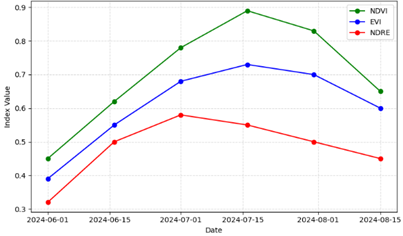Predicting Rice Yield Using Multi-Temporal Vegetation Indices and Machine Learning: A Comparative Study of Random Forest and Support Vector Regression Models
Keywords:
Rice Yield Prediction, Remote Sensing, Vegetation Indices, NDVI, EVI, NDRE, Machine Learning, Random Forest, Support Vector Regression, Time-Series DataAbstract
Accurate prediction of rice yield is essential for ensuring food security and optimizing agricultural management practices. This study integrates multi-temporal remote sensing vegetation indices—Normalized Difference Vegetation Index (NDVI), Enhanced Vegetation Index (EVI), and Normalized Difference Red Edge (NDRE)—with advanced machine learning algorithms to forecast rice yield. Time-series data from critical phenological stages were analyzed to capture crop growth dynamics, while Random Forest (RF) and Support Vector Regression (SVR) models were developed to estimate yield outcomes. Results indicate that the RF model outperforms SVR in predictive accuracy, with an R² value of 0.92 compared to 0.87 for SVR. Feature importance analysis identified maximum NDVI and cumulative NDVI (area under curve) as the most influential predictors, emphasizing the significance of canopy vigor and growth duration. Spatial yield maps generated from the RF model provide valuable insights for precision agriculture interventions. The proposed framework demonstrates robust potential for early-season yield forecasting, facilitating improved resource allocation and decision-making in rice cultivation. Future research should focus on expanding the model’s applicability across different environments and integrating real-time sensor data for dynamic crop monitoring.


